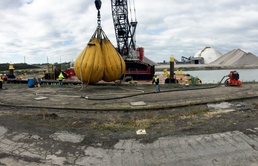
Through the consistent, progressive efforts of the U.S. Army Corps of Engineers, Buffalo District employees, the old derrick boat “McCauley” has been converted to a crane barge, and was returned to service upon the successful completion of a load test, October 16.
Replacement of the aging crane that was formerly on the McCauley ensures the safety of the public and Corps of Engineers workforce.
A derrickboat is a floating crane with the crane permanently attached to the barge, whereas a crane barge is designed to carry a crane that is not permanently fixed to the barge. The Buffalo District’s Derrick boat McCauley is operated by the staff of the Ohio Operations and Maintenance (O&M) Office.
Last year, an inspection of the McCauley identified deficiencies signifying that the derrick boat was no longer safe to operate, ending almost 70 years of service, circa 1948. The McCauley’s home port is Cleveland, OH, but it was disserviced last year at the Kinder Morgan Pinney Dock in Ashtabula, Ohio, the same location the load test occurred.
Given its age and declining condition, a long-term capital replacement project for the McCauley has been in the works for several years. Delivery of a new modern derrickboat, capable of meeting all District O&M requirements, is expected in the spring of 2021. In order to continue the mission of performing critical harbor infrastructure maintenance on Lakes Erie and Ontario, an interim solution was needed.
After reviewing the feasibility and cost of numerous options, it was determined that the most efficient and cost effective action was conversion of the derrickboat to a crane barge. The conversion of the McCauley to a crane barge was feasible because the barge itself is in good condition, having undergone significant repairs over the past 10 years.
A year-long design and shipyard construction effort removed the old fixed crane and replaced the old crane platform with a suitable platform to carry a crawler crane on the barge. Design, engineering, vessel inspection, quality assurance, and full Naval Architectural Analysis were performed/prepared by the U.S. Army Corps of Engineers, Marine Design Center.
“Putting this new crane into service gives us a modern and reliable tool for performing our mission,” said Paul Bijhouwer, District Load Handling Equipment Program Manager.
The final project milestone was a load test of the newly converted crane barge and rental crawler crane. The main hoist of the crane on the McCauley was put to the test picking up over 40 tons (80,200 lbs.) at a radius of 40 feet, just over the side of the barge.
“The test involved attaching giant water bags to the crane and filling them to achieve the correct weight,” said Bijhouwer. “Once lifted, the test load was held with the brake for 5 minutes to verify that it was not slipping. The crane was then rotated a full 360 degrees at the 40 foot radius, all the way around the ship, to verify that the crane and barge would not lean over more than allowable under the test weight.”
Upon completion, a separate test of the crane auxiliary hoist was performed. This hoist was tested with 14.6 tons (29,200 lbs.) at a radius of 90 feet. Both tests were fully successful, with the crane and barge performing well within limits under load conditions that represent the extremes of what will be expected from them while in service on the water.
“[This] will make this job great,” said James Boyd, a member of the USACE Buffalo District floating plant crew. “We will have a reliable crane that will help us attack a backlog of work, and that is exciting. The crew is ready and eager to deliver, and ensure our navigation structures continue to function as designed.”
Return to service of the Buffalo District Repair Fleet restores the capability to perform critical infrastructure maintenance at Great Lakes Harbors. The Corps of Engineers will put the converted crane barge, McCauley back to work until the season ends on November 9, 2018, and again in 2019 and 2020.
“It has been a long process to get us operating again, but this solution will keep us running until 2021 when the new derrick boat is put into service,” stated Bijhouwer as he celebrated the successful completion of the load test.